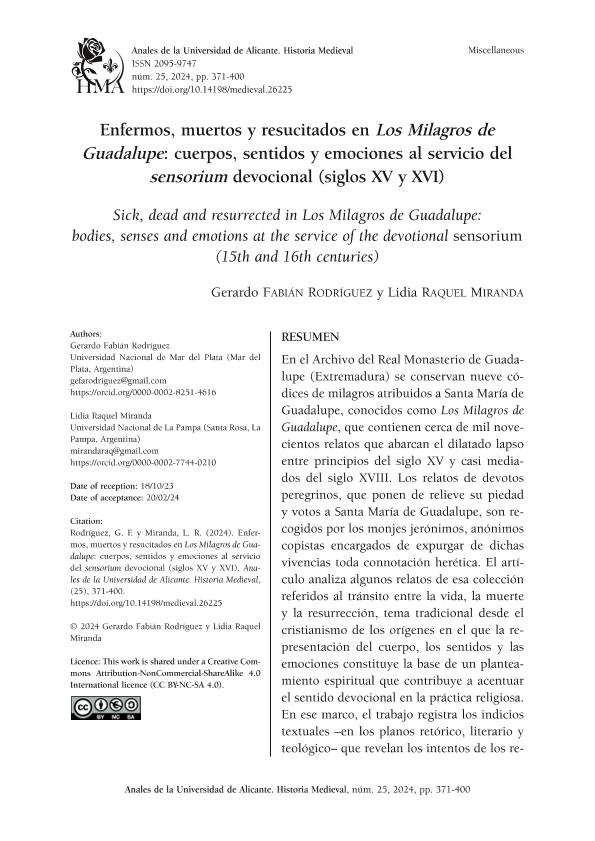Artículo
En el Archivo del Real Monasterio de Guadalupe (Extremadura) se conservan nueve códices de milagros atribuidos a Santa María de Guadalupe, conocidos como Los Milagros de Guadalupe, que contienen cerca de mil novecientos relatos que abarcan el dilatado lapso entre principios del siglo XV y casi mediados del siglo XVIII. Los relatos de devotos peregrinos, que ponen de relieve su piedad y votos a Santa María de Guadalupe, son recogidos por los monjes jerónimos, anónimos copistas encargados de expurgar de dichas vivencias toda connotación herética. El artículo analiza algunos relatos de esa colección referidos al tránsito entre la vida, la muerte y la resurrección, tema tradicional desde el cristianismo de los orígenes en el que la representación del cuerpo, los sentidos y las emociones constituye la base de un planteamiento espiritual que contribuye a acentuar el sentido devocional en la práctica religiosa. En ese marco, el trabajo registra los indicios textuales –en los planos retórico, literario y teológico– que revelan los intentos de los redactores de la colección por ceñir el sensorium devocional a la ortodoxia cristiana, es decir por orientarlo hacia el hagiosensorium. En relación con la representación de enfermos, muertos y resucitados, se presta especial atención a los contextos milagrosos en que dichos personajes aparecen y a la secuencia promesa realizada-gracia recibida-promesa cumplida, modelo de intercambio de dones y agradecimientos que, en términos generales, se reconoce en todas las fuentes examinadas. In the Archive of the Royal Monastery of Guadalupe (Extremadura) there are nine codices of miracles attributed to Saint Mary of Guadalupe, known as Los Milagros de Guadalupe, which contain nearly one thousand nine hundred stories that cover the long period between the beginning of the 15th century and almost mid-18th century. The devout pilgrims told their reports to highlight their piety and vows to Saint Mary of Guadalupe. They were collected by anonymous Hieronymite copyists, who expurgated any heretical connotations from said experiences. The article analyses some stories from that collection referring to the transition between life, death and resurrection, a traditional theme since early Christianity in which the representation of the body, the senses and the emotions constitutes the basis of a spiritual approach that contributes to accentuate the sense of devotion in religious practice. In this way, the paper records the textual indications –on the rhetorical, literary and theological levels– that reveal the attempts of the editors of the collection to adhere the devotional sensorium to Christian orthodoxy, that is, to orient it towards the hagiosensorium. In relation to the representation of the sick, dead and resurrected people, special attention is given to the miraculous contexts in which these characters appear and to the sequence promise made-grace received-promise achieved, a model of exchange of gifts and gratitude that, in general terms, is recognized in all sources examined.
Enfermos, muertos y resucitados en Los Milagros de Guadalupe: cuerpos, sentidos y emociones al servicio del sensorium devocional (siglos XV y XVI)
Título:
Sick, dead and resurrected in Los Milagros de Guadalupe: bodies, senses and emotions at the service of the devotional sensorium (15th and 16th centuries)
Fecha de publicación:
03/2024
Editorial:
Universidad de Alicante
Revista:
Anales de la Universidad de Alicante
e-ISSN:
2695-9747
Idioma:
Español
Tipo de recurso:
Artículo publicado
Clasificación temática:
Resumen
Palabras clave:
MILAGROS
,
MUERTOS
,
ENFERMOS
,
RESUCITADOS
Archivos asociados
Licencia
Identificadores
Colecciones
Articulos(CCT - PATAGONIA CONFLUENCIA)
Articulos de CTRO.CIENTIFICO TECNOL.CONICET - PATAGONIA CONFLUENCIA
Articulos de CTRO.CIENTIFICO TECNOL.CONICET - PATAGONIA CONFLUENCIA
Citación
Rodríguez, Gerardo Fabián; Miranda, Lidia Raquel; Enfermos, muertos y resucitados en Los Milagros de Guadalupe: cuerpos, sentidos y emociones al servicio del sensorium devocional (siglos XV y XVI); Universidad de Alicante; Anales de la Universidad de Alicante; 25; 3-2024; 371-400
Compartir
Altmétricas




